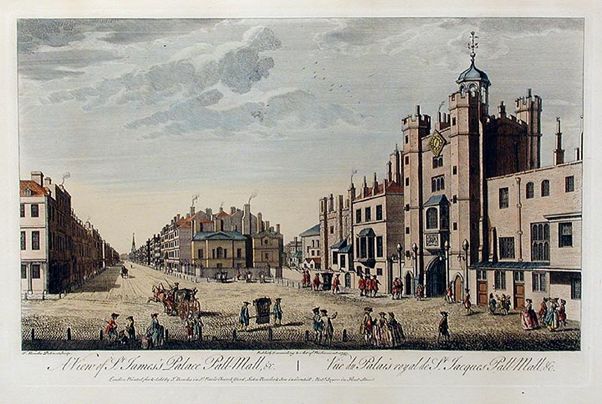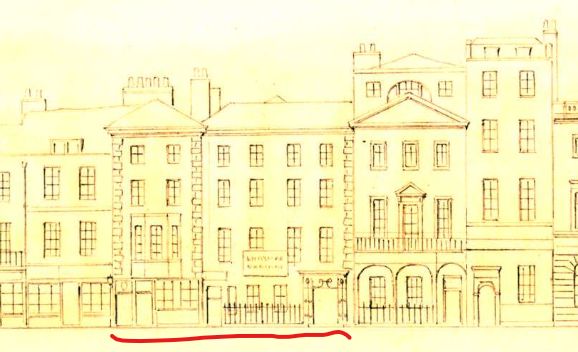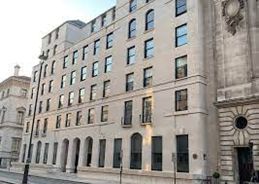Contents
Introduction
Let me start by saying that the Star and Garter was never a cricket club, rather it was an inn or tavern in Pall Mall, a prestigious road in West Central London. Here Noblemen and Gentlemen gathered in the eighteenth century; its facilities are understood to have largely consisted of a series of private dining rooms which could be hired by groups and where fine wines would be served. As we will see it played a huge role in cricket history.
After the restoration of the monarchy in in 1660, the aristocracy enjoyed new prestige and confidence. The Great Fire of 1666 had opening up the possibility of rebuilding the city and many noble families had taken advantage of this by constructing palaces and other large houses in the area to the West of the City. Hence there was a population of young affluent men in this area with the time and money to set about having a thoroughly good time; many of these attended the Star and Garter.
The Club was the venue for the first meetings of the Jockey Club in the 1750s, this giving an indication the interests of the membership. More particularly it played an important role in the development of cricket in London.
Location

The location of the cricketing Star and Garter is not known with absolute certainty. That is because were two taverns on Pall Mall that bore this name. One was a modest Inn on the north side of the street, on the site of the present No. 44 Pall Mall, opposite to Schomberg House. The other Star and Garter stood on the south side of Pall Mall, numbered 94-95, and was altogether a grander establishment, famous for its fine claret and exclusive dining rooms. There is widespread agreement that this is the tavern we are interested in – we are fortunate in having a drawing by John Coney in 1796 of its outward appearance (relevant buildings underlined in red):

This shows a four-storeyed building of early eighteenth-century character, probably two houses originally; that to the east (to the left above) having a narrow front projecting from its neighbour. It is described on British History as follows: “The east house had a shop at ground-floor level, a prominent canted bay on the first floor, and two windows in each succeeding storey, the front being quoined at the angles and finished with an eaves-cornice and a hipped roof. The western house had a rusticated Doric porch to the west of the three ground-floor windows, and four windows in each upper storey. The angle quoins and eaves-cornice were uniform with those of the eastern house.”

The buildings in this terrace were demolished in the Nineteen Century and replaced by the Carlton Club. In the twentieth century, the building was again replaced, this time by a bland office block numbered 100 and covering the numbers 90 – 100 (left). The precise location of the Inn would be near the centre of this building; sadly, there is no plaque to mark the significance of this site. The older building next door, a fragment of which is visible on the right of the picture, is the Royal Automobile Club. The street on the far side of this building is Carlton Gardens.
Coincidentally, the Rugby Football Union was founded nearby, at a meeting at the Pall Mall Restaurant on 26 January 1871.
Connections with cricket
The aristocrats who made use of the Star and Garter were drawn to sport, not least for its potential for gambling and this was to feature prominently in their agenda. It was here that the early meetings of the Jockey Club were held around 1750. They promoted cricket as well, setting matches up and then wagering on results. Their enthusiasm and wealth were to move cricket from a rural game into something approaching a professional business. There are at least four important developments that in which attendees of the Inn played a major part:
The London Cricket Club
The original London Cricket Club was formed in or around 1722 by patrons of the Start and Garter and was one of the foremost clubs in English cricket over the next four decades. It is closely associated with the Artillery Ground, where it played most of its home matches, where there are records of much gambling taking place.
The London Cricket Club faded away during the Seven Years’ War (1756 – 1763) as aristocrats retreated to the countryside.
The Laws
The Star and Garter was the location for important meetings concerning formal codification of the Laws of Cricket. In particular, there are the editions printed in 1755 and in 1774, both of which specify that they were agreed at the Star and Garter. The 1774 code is recorded as being settled by a Committee of Noblemen and Gentlemen of Kent, Hampshire, Surrey, Sussex, Middlesex, and London. This we can see the grouping from which the MCC would emerge was already establishing a grip on the game.
The Je-ne-sais-quoi / White Conduit Club
Pelham Warner, in his history of the Marylebone Cricket club records that the Star and Garter was the location where members of an aristocratic group called the Je-ne-sais-quoi were wont to meet. From at least 1782, a subgroup of these also played cricket close to the pleasure park in Islington known as the White Conduit Fields, where the game had been played since at least 1718. They seem to have filled the space left by the now defunct London Cricket Club and comprised what became known as the White Conduit Club, supposedly consisting solely of the upper echelons and playing several important matches.
Marylebone Cricket Club
The ground at White Conduit Fields however, was not satisfactory. A public footpath crossed over it and there was no privacy for the players. One of the team who played there, one who was actually a member of the lower echelons, was Thomas Lord, an enterprising and ambitious wine merchant with contacts in the world of property. He was given the task of finding a ground where the gentlemen players could perform behind a barrier, to afford them decent privacy or, perhaps, so an entrance fee could be charged. He came up with the ground at what is now Dorset Square which he purchased himself and rented to the players, or at least, to some of them. The first match was played there in 1787 and the lessees of the ground were to organise themselves as the Marylebone Cricket Club – who need no introduction.
